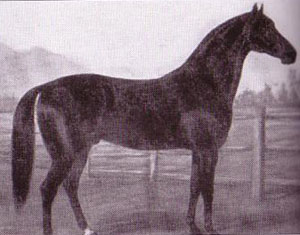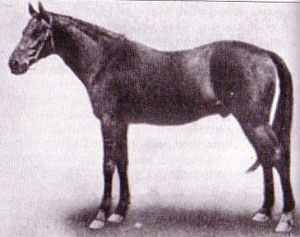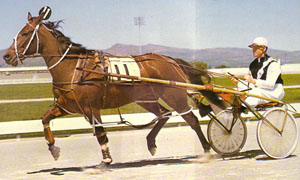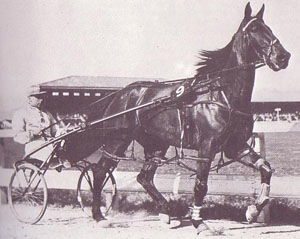| HORSES |
YEAR: 1881
 |
At first glace it would seem out of place to list a horse among the great stud sires who had not sired more than 60 winners which is a commonplace figure today. But Berlin, a sire with such a record, has a special place in our breeding history. For one thing, he was the first trotting bred stallion ever to stand in this country, being imported in 1881. For another he became a major influence on our breeding development as can be seen as his stud career unfolds. His 60 winners came at a time when trotting was in it's infancy and his achievements pro rata would equal most leading sires who followed him. He produced two horses who could fairly be called champions and one other who came very close to that rating, and his daughters bred on well. There are not many top families who do not carry Berlin blood somewhere along the line.
Bred in 1870 Berlin was exported to Scotland before racing and he was sold to New Zealander Robert Wilkin as a ten year old. Mr Wilkin was a businessman of substantial reputation who had a fondness for acquiring the fastest buggy horses around to help him beat the opposition on Christchurch roads. To steal a march on his rivals and to generally improve the breed of utility horses Mr Wilkin brought out Berlin and stood him at his Fendalton Stud. In later years he imported a number of others and mares who were extremely successful and he is generally recognised as the pioneer trotting studmaster. Whether in fact Mr Wilkin originally intended his imported stock to be primarily producers of racehorses however is open to debate.
Berlin was well-bred by American standards. His sire Woodford Mambrino had an unusual career racing once at three and not appearing on the track again for eight years. In between times he stood at the stud and did not get many mares and he only produced about 100 known foals. Many of these became fine performers and one of his sons, Pancoast, was sold at auction in 1886 for $28,000 which was a record price for a sire at that time.
In NZ, with no opposition of course, Berlin became very popular for he was described as a handsome bay of balanced proportions. Indeed some breeders became just a bit ambitious in getting his stock on the market for it was noted at the time that several yearlings by Berlin had been sold at auction before his first progeny appeared. Encouraged by Berlin's success Mr Wilkin then made more purchases this time in America and nearly all were successful. The tragedy for us was however that he leased Vancleve to Australia for two years and so successful was he that he never got back to this country, though a number of his stock were imported here.
Berlin however was sent mares of all descriptions and pedigrees but soon a number were showing to advantage on the racetrack and his matings with Wilkin's imported mares produced particular success.
His first track star was Callista a mare from Southern Queen who was predominantly thoroughbred in blood. Ashburton owned, Callista gave regular thrashings to assorted fields in the late 1880s and early '90s. And was our first recordholder over two miles. He saddle time of 5:22 made in Christchurch on a day when she had already won a race was followed by a 5:36 time in harness which remained for some years. At one stage Callista was owned by Dan O'Brien of Carbine fame but she became inconsistent in her form and was taken to Australia where she was asked to concede starts of up to half a mile in a three mile race. She was ultimately disqualified in that country and legend has it that she then went to America. Although the more cynical considered that she may well have been scoring victories in the country meetings around Australia under an assumed name, for such things were not unusual at that time.
Another by Berlin was Kentucky a son of the imported Jeannie Tracey. A trotter, Kentucky was the champion of his year and his influence on our breeding can never be erased, if only for one of his daughters - Thelma, the greatest broodmare ever bred in NZ. Contractor (5 wins) was another top horse of the late '80s while Stonewall Jackson by Berlin from Pride Of Lincoln (dam of Thelma) was the Robalan of his era. He won ten races which was a record in his day and won a number of them from the stable of young Freeman Holmes who raced him on lease. It was not unusual for Stonewall Jackson, a big versitile pacer, to concede starts of nearly 20 seconds to his rivals in two mile races - the equivalent today of 200 metres.
Wilkin, the result of a mating of Berlin and the great Polly, ancestress of over 85 winners, was another recordholder of his day taking a mile time of 2:16. Other fine performers he sired were Fraulein, Shamrock, Young Berlin, Berlin Maid, Patchwork and General Tracey. Berlin was easily the leading sire of his day. His 60 winners were accumulated at a time when trotting meetings were not as common as they are today. In addition the programmes were often of five races and these included at least one pony event which restricted sires of the time in amassing impressive records. It is not known how many mares Berlin served before his death in 1896 but it can be fairly claimed that few of them ever saw the racetrack. They were used as buggy horses, their owners producing the three or five guinea service fee either at the Fendalton Stud or when Berlin was taken 'on tour'.
If Berlin made a big impression with his immediate offspring his feats as a broodmare sire were even more impressive. Fraulein (from the imported Woodburn Maid) won one race only but produced at stud the wonderful Fritz, the greatest trotter of his time, perhaps anywhere in the world. Australian and NZ crowds loved this game foolproof trotter who, in dozens of starts, broke his gait only once. His full-brother Franz was also a noted performer and later a successful sire. Puella, a full-sister to Fraulein was the dam of Belmont M and Almont two top performers in their time. Almont, who was also a successful sire, held the three mile record for many years when that was a popular distance. In fact if it comes to that he probably still does hold it. Brown Duchess was another daughter to breed on, and the family she established produced in recent years, the top pacer Leading Light. Patchwork became the dam of the well performed Needle Work.
Another great foundation mare by Berlin was Regina who was ancestress of Logan Chief, Native Chief, Grand Mogul, Walter Moore and Southern Smile amongst others. Regina is typical of many of the mares Berlin had to serve being of doubtful ancestry though thought to be thoroughbred. Minto claims Parisienne, Garcon Roux and Soangetaha among her descendants.
If Berlin has had considerable influence through his daughters (and we have only skimmed the surface here), he has had a wide influence through his sons also perhaps more so than most other sires to stand here. He had a good start of course. Being the first trotting bred stallion in the country it was natural that owners of his sons were keen to put them to stud and many of them held their own against the increasing number of imported stock. One of his best sons was Contractor who seems to be missing from registered sires lists. A good winner himself Contractor sired Specification who at Lancaster Park in 1894 lowered the world record for four miles covering the distance in 10:47 although there seem to be some argument over the time. Contractor was still racing at this stage. Specification himself was a successful sire in later years.
Prince Bismark, another unregistered stallion, sired Ruahine who in turn produced the Australasian pacing champion Dan Patch in the early years of this century, Dan Patch took a 2:09.4 mile time but unfortunately died early and had virtually no stud career.
So although Berlin may not be a name which springs to mind as a great sire there are any number of top horses which carry his blood in their veins. The old fellow mightn't have a lot going for him on paper in terms of winners and stakemoney but he was our first champion sire and considering many of his stock never saw a racetrack he can hold his head up with any of the great sires who followed him.
Credit: David McCarthy writting in NZ Trotguide 14Oct76
YEAR: 1881
 |
In any survey of great stallions of past decades, the case of Vancleve would never be challenged as being the most unusual.
Although sires earnings were not officially recorded until well into this century there is little doubt that Vancleve would have topped such a list at least once and would have been in the top five over a number of years. The fascinating thing about that is that Vancleve never stood at stud in this country and as far as is known, never left a foal here. His influence was based solely on Australian imports as he spent all of his stud career in that country. He did pass through NZ in the early 1880's but there is no record of his having served any mares and even if he did their subsequent stock are lost in the mists of time. And while other Australian-based sires notably, Ribbonwood and Globe Derby have influenced our racing, none had the impact of Vancleve.
Foaled in 1881, Vancleve was imported to NZ by Robert Wilkin the following year along with another colt Blackwood Abdallah and several mares. Mr Wilkin already had Berlin at stud so decided to lease Vancleve for two years to Mr Andrew Town owner of the big Hobartville Stud in New South Wales. Vancleve was so successful he never returned to this country and Mr Town later bought him outright. It is understood Mr Wilkin did make attempts to get his horse back at the end of the lease but, as often happens in such cases, there was always good reasons why he could not travel. Vancleve raced occasionally across the Tasman and was in fact the first horse to break standard time in Australia going 2:28 in 1893. This made him much faster than the NZ champions on the day.
While Vancleve had tremendous influence on Australian trotting it is his NZ success which we are concerned with here. But in passing it might be noted that his daughter Fidget was the grandam of the mighty Globe Derby the greatest colonial bred sire. Vancleve produced pacers and trotters with equal ease though many of his pacers were free-legged performers. His greatest son was Fritz. Fredrick and Franz were full brothers to Fritz and were also fine performers, while in Australia one of Vancleve's sons in Valour won many races and took a 2:16 mile time. Another outstanding son of Vancleve was Vascoe who was Australian-bred but who made most of his reputation in NZ from Free Holmes' stable. Vascoe was the leading stake winner in the 1901-02 season and won races over many seasons.
Many of the Vancleve horses which made good in this country were brought over by Mr James Buckland who campaigned teams here at the turn of the century. Other Vancleve winners he brought were Viva and What. Undoubtedly the best pacer he brought over however was Durbar. Durbar won in Mr Buckland's colours before being purchased by Mr H F Nicoll and for his new owner he won many races including the National Cup and the NZ Cup of 1908, the Otahuhu Cup of 1903 and two other placings in the NZ Cup. Mr Nicoll named his well known Durbar Lodge after his old favourite.
Another top horse Vancleve produced and who came to this country was Quincey a trotter who won the inaugural Dominion Handicap from the Ashburton stable of S Scott who later stood the Vancleve horse at stud. Quincey's dam had been imported from America and he had fair success as a sire. Altogether Vancleve sired more than 60 winners in this country which in those days was a fine achievement for any sire, never mind one who never stood at stud here. Among them were Van Dieman who won an Auckland Cup, Vanquish, Verity, Archangel, Valmond and Velox the latter winning six races in the 1902-03 season in spite of being barely 14 hands.
As a sire of broodmares Vancleve was even more successful and a number of his daughters were particularly fine producers. The most successful has been Verity the second most successful broodmare this country has ever seen and steadily making ground on the famous Thelma. At last count her family had produced 154 winner-producing mares of over 380 races. Verity has achieved most of her stud renown (she was a fine pacer herself) through her daughters Pearlchild and Pansey to whom any number of fine horses trace.
In Australia, Vancleve was the sire of Doris M two of whose sons Hardy Wilkes and Pedro Pronto did very well in this country when brought over by Jack Kennerly. Hardy Wilkes was a fine trotter and Pedro Pronto almost in the champion class as a pacer, and later a successful sire. Vanquish another Vancleve mare was the grandam of the champion trotting mare Worthy Queen. Other Vancleve mares who established successful families here were Daybreak, Whist, Archangel, Cling and Ella G the latter the grandam of Captain Sandy.
Vancleve didn't have a very successful sire line though Franz must have had considerable influence for his name is in the pedigrees of some of our best trotting families including that of Whispering Grass (dam of Sea Gift winner of 18 and grandam of Durban Chief) and Olive Turmoil the ancestress of Court Martial, Nigel Craig, etc.
Most of his later influence was through his daughters which is not surprising when you look at Vancleve's own pedigree. Vancleve was by Harold, an intensely in-bred stallion, as both his sire and his dam were by Abdallah. Harold was by Hambletonian from Enchantress a mare which spent most of her life at work in a New York livery stable. He was an undergrown awkward colt treated as a no hoper for much of his life but subsequently proved to be one of the great trotting sires in North America. Vancleve's dam Vassar was by Belmont (also a son of Abdallah) from Venus, a mare by the much scorned stallion Seeley's American Star. Interestingly enough though, Harold had a fine stud reputation just before his death. Subsequently his daughters bred on better than his sons and the same happened with Vancleve.
It was a sad day for NZ breeding when Vancleve was shipped over to Australia, but all the same he made an immense contribution to the evolution of our standardbred without ever standing in the country where he was a leading sire.
Credit: David McCarthy writing in NZ Trotguide 28Oct76
 |
A winner over two miles in 4.19 as a 3-year-old, Arapaho brought himself into light harness racing prominence as a 4-year-old when he won the New Brighton Stars Travel Mile at the Addington track. Starting from a second row barrier and running against the elite of NZ pacers, Arapaho ran the distance in 1:59 in conditions that were anything but favourable. Arapaho defeated the Australian Bay Foyle, who ran second and also had to contend with a second row barrier draw, Robalan and Radiant Globe.
Arapaho became the first of his sire, Bachelor Hanover's progeny to enter the two-minute list.
Arapaho won 10 races, was second twice and third twice as a 4-year-old for prizemoney, $31,740 to be the leading NZ stakewinner in 1971-2. Arapaho was subsequently voted the NZ Harness Horse-of-the-Year in 1972.
In February, 1973, Arapaho set a world record in winning the Dunedin Festival Cup. He ran the 11 furlongs from a standing start in 2:48 3/5, a mile rate of 2:02 3/5. This clipped 1 3/5 off the world record set by Johnny Globe, in 1955. Following his success in the Dunedin Festival Cup, Arapaho raced in Sydney in the 1973 Inter-Dominion Championship series. He was defeated into second placing by the championship winner, Hondo Grattan, in the first heat he contested but won the next heat. He qualified for the final, but ran unplaced from the 12 yard mark.
During the 1973-4 season Arapaho was again the leading stake-earner in NZ with earnings of $69,375 for the season. This followed wins in the prestigious NZ Cup and the Auckland Cup in 1973.
Arapaho was sold to Canadian owners and left NZ late in 1974.
Credit: Ron Jenkins: Great Trotters
 |
The NZ mare Blue Mist, in seven seasons of racing, proved herself an outstanding performer over all distances and one of the best racemares produced in that country. When she was retired in 1953 she had contested 77 races for 19 wins and 20 placings. Her earnings totalled £16,230 and at that time was second only to Loyal Nurse as the highest stakewinning mare in Australia or NZ.
In 1951 at the Inter-Dominion Championship at Addington, she won her 1½ miles heat in the NZ record winning time of 3:08. She won many cup races in NZ throughout her career but when taken to Australia in 1953 she put up possibly her most memorable performances. In the Inter-Dominion Championship at Perth that year, Blue Mist was winner of the first two heats over 1½ miles and 1¾ miles and was fourth in her third heat, all from the 24 yeard handicap mark. She finished fifth in the Grand Final and was considered extremely unlucky, meeting two checks in the running.
She followed this up by winning two free-for-all events and then, in the two-mile WA Easter Cup, she started from the backmark but annihilated the field, winning by 40 yards in a record time of 4:16.
In March, 1953, Blue Mist ran a mile and a half against time at Bunbury, WA, in 3:03¼, a world record for that distance. She ran the half mile in 60½, the mile in 2:01 and the full distance in 3:03¼, easily beating Scottish Pence's American and world mark of 3:06.
At stud, Blue Mist produced two foals. The second of these was Medium Blue, a good open class performer at Harold Park in the early 1960's.
Credit: Ron Jenkins: Great Trotters
| << PREVIOUS | 1 2 3 4 5 6 7 8 9 10 11 12 13 14 15 16 17 18 19 20 21 22 23 24 25 26 27 28 29 30 31 | NEXT >> |